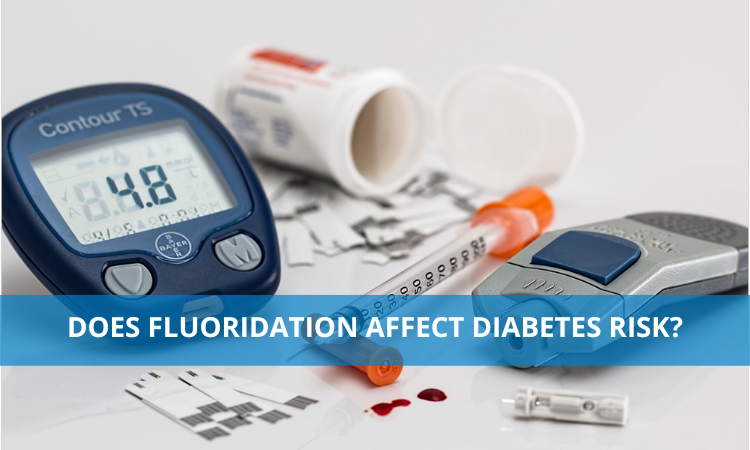
Given that sodium fluoride is a recognized blood glucose preserver, the data showed that sodium fluoridation might cause a rise in diabetes incidence in the United States.
Fluoride has been found to raise blood sugar levels and reduce glucose tolerance, perhaps by preventing insulin generation or secretion. A dose of fluoride that can be attained in locations with "optimally" fluoridated water has been proven to cause impaired glucose tolerance in humans, which is frequently a precursor to type 2 diabetes. This intake ranges from 0.07 to 0.4 mg/kg/day. Therefore, current fluoride intake may cause or aggravate some types of diabetes.
"Any involvement of fluoride exposure in the development of impaired glucose metabolism or diabetes is potentially substantial," the National Research Council (2006) stated. Additionally, since they often drink more water than people without diabetes, diabetics can significantly increase their daily fluoride intake through water and other liquids. Therefore, diabetics are a "sensitive subpopulation" regarding fluoride exposure and may be more susceptible to fluoride's negative effects.
Higher blood glucose
Blood sugar levels rise as carbs are ingested and absorbed. Chronically increased blood sugar, or hyperglycemia can cause life-threatening consequences if the body cannot control the amount of glucose in the blood, as is the case with diabetes mellitus. These could involve harm to the kidneys, the brain and nerve system, the cardiovascular system, the retina, the legs, and feet, etc. Studies on both humans and animals have revealed that high fluoride intake raises blood fluoride levels and simultaneously raises serum glucose levels.
Insulin and glucose intolerance prevention
The pancreas secretes the hormone insulin, which is in charge of ensuring proper blood glucose levels. The hormone insulin enables the body's cells to absorb glucose from the blood and utilize it as fuel or store it as glycogen. Diabetes mellitus, or type 1 diabetes mellitus, is characterized by insufficient insulin production, but type 2 diabetes mellitus is characterized by insulin resistance or cells that are less receptive to the insulin that is produced by the body.
The body's inability to effectively remove glucose from the bloodstream is referred to as glucose intolerance (or impaired glucose tolerance). When a glucose tolerance test after two hours reveals blood glucose levels that are increased but below the threshold for type 2 diabetes mellitus, the subject is said to have impaired glucose tolerance.
Fluoride-related impairments in glucose tolerance appear to be primarily caused by a pancreatic cell-mediated reduction of insulin production. Studies on both animals and people have shown that eating fluoride temporarily inhibits the release of insulin, which causes hyperglycaemia. (elevated blood sugar). Fluoride may potentially increase insulin resistance or impair insulin sensitivity, which might help explain why some people have trouble handling glucose.
Fluoride exposure estimation
Fluegge, a health economist with the health department of New York City, finished his studies there as a post-doctoral fellow. He investigated relationships between diabetes incidence and fluoride levels in 22 states using mathematical models and data that was made available to the public. Obesity and inactivity were accounted for in the study. His findings suggest that increasing T2D rates between 2005 and 2010 were strongly correlated with adding sodium fluoride to public drinking water, according to 2 sets of regression analysis.
He discovered that an increase of 1 mg in the typical county fluoride level anticipated an increase in age-adjusted T2D prevalence of 0.17 percent. Additionally, not all regions of the nation use the same addition, and they appear to have various impacts on diabetes. Fluegge discovered that, in contrast to sodium fluoride, fluorosilicic acid was linked to drops in diabetes incidence and prevalence, suggesting that it may help treat T2D. Conversely, diabetes rates were lower in regions where water fluoride levels were natural.
The connections were made clear when Fluegge modified fluoride exposure levels to account for expected per-capita tap water use. According to the models, "the link between water fluoridation and diabetes outcomes depends on the per capita intake of tap water," the man added. In other words, using parts per million data alone won't provide much information; instead, one must go the extra mile and measure what people actually consume.
Fluegge asserted that while his study by itself shouldn't lead to changes in policy, it does point to the necessity for greater investigation. Studies of individuals must be conducted after population-level relationships, and other fluoride sources must be considered.
Conclusion
Dental cavities are a costly public health issue, but water fluoridation prevents them. However, despite the advantages, the topic of additional water fluoridation is still debatable. Some claim it could lead to long-term health issues; however, studies examining the adverse effects have been scant or inconclusive. It's still unknown how long-term fluoride consumption will have an impact.
An investigation of the relationship between water fluoridation and diabetes was recently published in the Journal of Water and Health. Type 2 diabetes is becoming more prevalent in the United States. In the past 32 years, incidence rates have nearly quadrupled, and they continue to rise. The chemical is known to preserve blood glucose, so the study suggests that sodium fluoridation may be a factor in the rise in diabetes incidence in the US.

Dr Amna Bilal
The author is a contributing writer at Dental News Pakistan and can be reached at amna0795@yahoo.com

